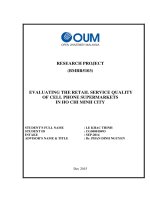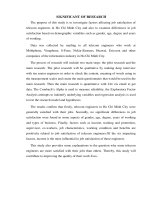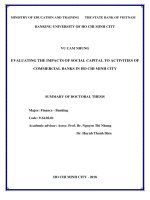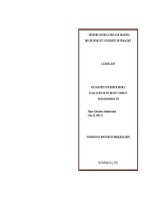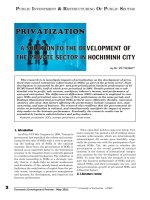Service quality of private universities in ho chi minh city
Bạn đang xem bản rút gọn của tài liệu. Xem và tải ngay bản đầy đủ của tài liệu tại đây (3.8 MB, 128 trang )
SERVICE QUALITY OF PRIVATE UNIVERSITIES
IN HO CHI MINH CITY
___________________________
A Dissertation
Presented to the Faculty of the Graduate School
Southern Luzon State University, Lucban, Quezon, Philippines
in Collaboration with
Thai Nguyen University, Socialist Republic of Vietnam
___________________________
In Partial Fulfillment
of the Requirements for the Degree
Doctor of Business Administration
___________________________
By
VU QUOC KHANH (CLINTON)
June 2018
i
ii
CERTIFICATE OF ORIGINALITY
This is to certify that the research work entitled “Service Quality of
Private Universities in Ho Chi Minh City” orally defended/presented under
the DBA program jointly offered by Southern Luzon State University of the
Republic of the Philippines and Thai Nguyen University of the Socialist Republic
of Vietnam, embodies the result of original work carried out by the undersigned.
This dissertation does not contain words or ideas taken from published
sources or written works by other persons which have been accepted as basis
for the award of any degree from other higher education institutions, except
where proper referencing and acknowledgement were made.
________________________
VU QUOC KHANH (Clinton)
Date Orally Defended: June 2018
iii
ACKNOWLEDGMENT
The researcher sincerely extends deepest gratitude and appreciation to
the following persons who give contributions in the completion of this study:
DR. WALBERTO A. MACARAAN, research adviser, for his valuable
advice, constructive criticisms, and patient encouragement; for sharing his
sheer intelligence; for helping the researcher to grow and have his skills and for
being the source of encouragement, the researcher humbly extends gratitude;
DR. DANG KIM VUI, president of Thai Nguyen University in the Socialist
Republic of Vietnam, for his untiring effort and belief that this collaboration is
possible thus enabling us to pursue the DBA degree;
DR. JOANNA PAULA A. ELLAGA, DR. CHONA V. CAYABAT, DR.
ERIBERTO
A.
CASIÑO,
DR.
MOSES
T.
MACALINAO,
and
DR.
FLORMANDO P. BALDOVINO, Oral Examination Committee, for their interest
in the researcher’s work, inputs, and for their valuable suggestions for the
improvement of this study;
IS-TNU staff, for providing necessary research materials;
Respondents, for their time, cooperation, honesty in answering the
guide questionnaire;
His parents, for the inspiration and encouragement to complete this
doctoral course; and
His family, friends and colleagues, for the love and support in one way
or the other; and to all who have contributed to make this study success.
VQK
iv
DEDICATION
This piece of work is humbly dedicated to
My colleagues and fellow instructors,
My students, my family and
My relatives, my friends,
My wife and children.
VQK
v
TABLE OF CONTENTS
PAGE
TITLE PAGE ………………………………………………………………..
i
APPROVAL SHEET ……………………………………………………….
ii
CERTIFICATE OF ORIGINALITY ………………………………………..
iii
ACKNOWLEDGEMENT ……………………………………………….….
iv
DEDICATION ………………………………………………….……...……
v
TABLE OF CONTENTS ……………………………………….………….
vi
LIST OF TABLES ………………………………………………………….
viii
LIST OF FIGURES ………………………………………………………...
ix
ABSTRACT …………………………………………………………………
x
CHAPTER
I
II
III
INTRODUCTION …………………………………….………
1
Background of the Study …………………………….….….
3
Objectives of the Study ……………………………………..
5
Null Hypotheses ...............................................................
6
Significance of the Study …..............................................
7
Scope and Limitation of the Study.....................................
7
Definition of Terms ……………………………….………….
8
REVIEW OF RELATED LITERATURE ……........….……
11
Conceptual Framework ……………………………………..
36
Research Paradigm …………………………………………
37
RESEARCH METHODOLOGY ……………………………
38
Research Design ………………………….…...……….…...
38
Locale of the Study ………………………………………….
38
Population and Sampling …………………………………...
39
Research Instrumentation ………………………………….
41
Data Gathering Procedure …………………………….……
42
Statistical Treatment …………………….…........…….……
43
vi
IV
RESULTS AND DISCUSSION …………...……………….
V
SUMMARY, FINDINGS, CONCLUSIONS AND
47
RECOMMENDATIONS
Summary ………………………….…………….……………
66
Findings ………………………….……………….………….
67
Conclusions ……………………………………………….....
70
Recommendations …………………………………………..
74
REFERENCES ……………………...………………………...……………
87
APPENDICES ……………………………………………………….……...
92
A. Instrument ………...……………………………………….……..
93
B. Computations …………………………………………………….
95
C. Plagiarism Check - Originality Report …………………………
116
CURRICULUM VITAE ……………………………………………….…….
117
vii
LIST OF TABLES
TABLE
PAGE
1
Sources of Service Quality Dimensions ………………………
36
2
Sample Size ……………………………………………………………
40
3
Number of students in respondent universities ……………..
48
4
Frequency distribution of respondent profile upon gender ...
48
5
Frequency distribution of respondent profile upon Courses ..
50
6
Frequency distribution of respondent profile upon year
level .......................................................................................
51
7
Quality of service provided by the private universities ………
52
8
Ratings of satisfaction descriptive statistics ……………….....
55
9
Ratings of satisfaction to services of the private
universities ……………………………………………………….
56
10
ANOVA for each dimension ……………………………………
59
11
ANOVA for the quality of services …………………………….
60
12
ANOVA for the profile of the respondents upon gender …….
61
13
Summary of Results of Anova Test for 3 Research
Hypotheses ………………………………………………………
69
viii
LIST OF FIGURES
FIGURE
PAGE
1
Service Quality Gap Model ..................................................
23
2
Gap 5 Model of Service Quality ..........................................
24
3
Research Paradigm .............................................................
37
4
Research Design .................................................................
46
5
Simple Strategic Development Plan ....................................
64
ix
ABSTRACT
Title of Research
: SERVICE QUALITY OF PRIVATE
UNIVERSITIES IN HO CHI MINH CITY
Researcher
: VU QUOC KHANH (Clinton)
Degree Conferred
: DOCTOR OF BUSINESS ADMINISTRATION
Name and Address
of Institution
: Southern Luzon State University, Lucban, Quezon,
Philippines and Thai Nguyen University, Socialist
Republic of Vietnam
Adviser
: Dr. Walberto A. Macaraan
Year Written
: 2018
Keywords
private universities, regression analysis, satisfaction,
service quality
______________________________________________________________
:
This research aimed to evaluate the service quality of twelve (12) private
universities in Ho Chi Minh City. This study is a descriptive research using
satisfaction questionnaire as a main tool to collect primary data, from the
sample size of 393 students studying in 12 private universities in Ho Chi Minh
City. This research used five variables to measure education services quality in
private universities including administrative services, qualification of lectures,
training and teaching program, physical facilities and equipment, extracurricular activities. The results show that there is no significant relationship
between administrative services and the student satisfaction. However, the rest
of the variables have positive and statistical significant influenced on student
satisfaction. There is a difference in student satisfaction by gender, year level
and faculties. Specifically, the satisfaction of service quality of the male and
female group was not different. Similarly, students in different year level have
the same satisfaction on service quality. However, students in different faculties
x
have different satisfaction. It was concluded that student satisfaction on the
quality of service of private universities in HCMC is influenced by factors
arranged in ascending order: extracurricular activities, training and teaching
program, qualification of lecturers, and physical facilities and equipment. A
number of recommendations from students' expectations and survey results,
together with discussions with the experts have been proposed.
xi
1
Chapter I
INTRODUCTION
Globalization is the trend of the times, and this not only in the field of
economy, trade, science and technology, but also being a strong impact to the
field of education of any country in the world. In Vietnam, the education system
in general and higher education in particular, with functional training high-quality
human resources for integration and development of the country, is no
exception to that trend.
In the past, education was viewed as a non-commercial, non-profit
humanitarian training activity but over a long period of time was influenced by
outside factors, especially the impact of the market economy has made the
nature of this activity not purely a public welfare but has gradually changed to
"educational services." Education becomes a form of service, and customers
can spend money to invest and use the service they think is best. This is the
reason that educational institutions are born to meet the needs of customer.
Bothpublicandprivatelyownedinstitutionsindifferentcountriesplayvital
roles in providing higher education. Higher education gradually has been
accepted as a type of service, the university is the service provider for the object
of his customers who are mostly students. Accordingly, one of the decisive
factors for the survival and development of the business unit general and units
in the field of education in particular is customer satisfaction for the quality of
products and services offered.
In the field of education, assessment of the service quality through
customer reviews, in which customer is the focus of students are becoming
essential. Service quality assessment will be conducted based on customer
2
feedback (Parasuraman et al., 2015). Clients of higher education services
include students, parents, business and teachers (Clare Chua, 2004; Firdaus,
2006; Costas & Vasiliki, 2007; Senthikumar & Arulraj, 2009). However, many
researchers believe that the main customer of higher education is the student
because the student is directly benefiting from the educational service.
Therefore, this study also uses the measure of the service quality of higher
education based on the opinions of those who have used this service – they
are students.
Indeed, issues such as poor training quality, graduation students do not
meet the demand for human resources of businesses coming mainly from the
fact that curriculum and teaching content are too heavy and even not suitable
for practice. Current Higher education of Viet Nam exists simultaneously two
systems: public and private. With the formation and development in the short
period of over 20years, system of private universities contributed remarkably to
comprehensive overview of non-public university system over the past 20
years. However, they have been still facing many limitations and challenges.
One of the reasons is not be able to deny, that is, Service Quality.
Indeed, by 2016, only 2 out of 60 private universities in the country were
accredited by the Ministry of Education and Training, of which Ho Chi Minh City
had only one university. Private universities in Viet Nam in general and in Ho
Chi Minh city in particular are not different from other businesses operate in a
competitive environment. It is undeniable that the existence and development
of universities in general, especially in private universities, in particular, was
decided mainly by the customers who use service products - these are the
students.
3
Besides, Private universities need to know what to do to in order to
satisfy their students because satisfied students can recommend their friends
and relatives to join these institutions in future. Service quality is one of the
factors that can lead to customer satisfaction (Kasper, Helsdingen &Gabbott's
2006). Service quality can be used as a strategy for competitive advantage
(Gronroos, 2007). For the purposes of determining and evaluating satisfaction
of students to have solutions aiming at improvement of the service quality in
universities in Ho Chi Minh city – the biggest city of Viet Nam - with population
of about 10 million residents.
According to the Ministry of Education and Training, Vietnam currently
has 145 public universities (excluding institutes), 60 private ones. In Ho Chi
Minh City alone, there are 49 public universities (belong to ministries, and
belong to the People Committee of HCM city) in which there are 37public
universities and 12 private universities founded in Ho Chi Minh city, the
researcher decided to study service quality of private universities in Ho Chi
Minh City.
Background of the Study
For Vietnam, in recent years, the education sector is changing much to
improve the quality of training services, avoid the negative in the industry. There
are a lot of research articles and topics aiming at setting up policies and plans
to improve the service quality in training schools at all levels, which will soon
bring the quality of Vietnam's education to the world‘s standard. One of the most
important levels is higher education as higher education is the place where the
skilled, technical and scientific labor force meets the demands of labor in
4
society. However, this force in Viet Nam is still underestimated. One of the main
reasons is that the provided service quality is still lacking. The Ministry of
Education and Training has launched a student-centered learning plan that is
to meet and satisfy basic needs for learners.
Associate Professor Pham Thi Huyen, a representative from a group of
independent researchers from number of universities and research institutes,
said the group had surveyed the status of non-public universities in the country.
The study found that the number of non-public universities increased from five
(1994) to 60 by the end of 2016, of which Ho Chi Minh City accounted for 20%.
There are more than 253,000 students in non-public universities, accounting
for 13%. Non-public universities, however, now have to compete unequally with
public schools having long history of development and state support for land,
finance, equipment, and human resources.
Associate Prof. Dr. Pham Thi Huyen said that on average, there are
about 3.6 training centers in each non-public university, reflecting the diversity
but also dispersed in training activities, making it difficult to create convenient
and good learning environment for students. It is worth noting that 5 out of 12
private universities have operated for more than 20 years but still have to hire
100% of training institutions. For the training of private universities, enrollment
is the most difficult problem in the present time. For 2013-2015, approximately
81,000 students enrolled in private universities each year. By 2016, this figure
is only more than 72,000 students, significantly affecting the operation of
universities. The main source of income for private universities is tuition fees.
The Vietnam Education Development Strategy sets a target of 40% of
the total number of students enrolled in private schools by 2020. However, the
5
trend in recent years, the number of students entering private schools not only
not increased, but also drastically reduced where the courses has to be closed
and the university is at risk of failure. In the past, private universities were mainly
based on the forces of lecturers from public universities. That is a temporary
solution. Visionary universities will have a strategy to build human resources
according to their own philosophy and will not copy the public school
governance model. To date, private schools account for only 19% of all
universities and 13.5% of students. Public schools are still mainstream. In
addition, along with online and cross-border education, students increasingly
choose. When a degree is no longer a guarantee of a good career, private
universities will have to make a real investment in and focus on service quality,
not just the place with function to grant degrees for students mainly.
Director of Education Testing and Accreditation in Ministry of Education
and Training - Mr. Mai Van Trinh affirmed: The reality is that universities that do
well in quality of higher education service will develop sustainably. Private
universities must develop and adhere to quality standards for higher education
in order to have proper investment and concentration plans for this mission.
This is one of the long-term solutions to improve the service quality for private
ones. Thus, research on the quality of service of private universities in Vietnam
in general and Ho Chi Minh City in particular is of significance for the
sustainable development of private universities.
Objectives of the Study
The study aimed to evaluate service quality among private universities
in Ho Chi Minh City, Viet Nam. Specifically, it aimed to attain the following
6
objectives:
1. Describe the profile of the respondents in terms of:
1.1 Gender,
1.2 Course/major field, and
1.3 Year level.
2. Determine the quality of service provided by private universities in terms of:
2.1 Administrative service,
2.2 Qualification of lecturers,
2.4 Training and teaching program,
2.4 Physical facilities and equipment, and
2.5 Extra-curricular activities.
3. Assess the general satisfaction of the respondents to the services of private
universities.
4. Determine the significant difference on the quality of services provided by the
private universities as perceived by the respondents.
5. Ascertain the significant difference on general satisfaction of respondents on
the services provided by private universities when grouped according to the
profile of the respondents.
6. Create a model for strategic development plan for the private university.
Null Hypotheses
There is no significant difference on the quality of services provided by
the private universities as perceived by the respondents.
There is no significant difference on general satisfaction of respondents
on the services provided by private universities when grouped according to the
profile of the respondents.
7
Significance of the Study
The study could be of help to the following beneficiaries:
Educational management organizations. Educational management
organizations have a comprehensive view about the real picture of current
service quality status of private universities in Ho Chi Minh city in order that they
have proper and appropriate policies. The research will also provide useful
information to policy makers in which it will be significant in providing direction
on quality service in higher education sector in Viet Nam.
Private universities. Private universities will know the level of student
satisfaction and which factor is the most important to focus on, undergo new
changes, help the universities serve students more effectively and improve their
quality of service to increase the satisfaction level of students.
Recruiters. Recruiters will be able to recruit human resources that best
meet their requirements. This does not only benefit universities or businesses
but also creates competition in international market. Universities cooperate with
businesses on all aspects of training such as program design according to
business requirements based on the principle of win - win.
Future researchers. Future researchers may discover more research
issues and expand the scopes of research. Researchers will gather more
information on measurement instruments and whether it might be improved
help deliver more suggestions on service quality.
Scope and Limitations
The study focused on service quality delivered by private universities in
Ho Chi Minh City. At the same time, the survey wasconductedin12 private
8
universities founded and located in Ho Chi Minh City - Viet Nam. About
respondents for evaluating service quality in universities, chosen respondents
will only be students attending in formal schooldays. Students are from the first
year to the final year.
Respondents will not include in-service students, graduate students
coming from most of the above-mentioned respondents will find it difficult to
give objective opinions on the quality of services because they are actually
employed, even if their jobs are very stable with high salary but their goal is to
get an expected degree to help them advanced. For employers or recruiters of
students in the 12 universities, conducting the survey to them is very complex
and takes more time and money. Those also lead to why sampling method will
be convenience sampling, not purposive or based on strata. It is also one of the
limitations of the study. Moreover, timeframe of the study had been 10 months
(2015-2016) from the time the researcher commenced the study.
Definition of Terms
To have provide a better understanding of some of the terms used in this
study, the following were theoretically and operationally defined:
Administrative Services play a vital role in service provision of a university. In
this study, administrative service was defined as service provided by
non-academic staff to students. As such, it includes such attributes as
attitude of administrative staff towards students. According to Abdullah
(2006), administrative services were understood to be non-academic
services provided by university to students. Administrative service was
considered quality of supervision and feedback from academic staff.
9
Customer Satisfaction is the level of a person's sense state that results from
comparing the results obtained from the product / service with his/her
expectations (Kotler, 2012). Expectation is considered human desire
and/or expectation. It derives from personal needs, past experiences
and external information such as advertising, word of mouth of friends
and family.
Extracurricular activities are performed outside of school hours, depending
on the interests, interests and aspirations of each student within the
framework of institution's ability and condition towards comprehensive
development for students. These activities are participated excluding
activities required to students aiming to receive a certain degree. When
students attended in extracurricular activities, they tend more positive
self-concept than students who did not attend these activities (Duque &
Weeks, 2010; Thompson et al., 2013).
Physical facilities and equipment are the physical means such as layout,
lighting, classroom, appearance of buildings and the overall cleanliness
used by teachers and students to effectively implement the education
program (Sohail & Shaikh, 2004). Modern educational facilities such as
library, textbook, learning and living environment are reliable equipment
to support and sustain teaching and learning. (Mavondo et al., 2000).
Private university is typically not operated by the government but may be
subject to government regulation. It is an institution of higher education
belonging to the national education system. Unlike public universities,
private universities do not receive state funding. Financial resources for
their activities are mainly from the tuition fees of students, the clients,
10
donations and even the owner. Tuition fees at these universities tend to
be much higher than public universities.
Qualification of lecturers is usually measured in three dimensions, they are
professional competence, teaching ability, and research ability. Good
lecturers provided more useful knowledge, skills, class notes, and the
reading materials, depth of lecture and teacher feedback on their work
(Dill, 2007). Besides, the qualification of lecturers is expressed through
empathy, trust, usefulness, willingness to answer student questions.
Service quality is a vital factor in the success of institutions as it affects
their survival, cost, profitability, and clients’ contentment. Quality is
one of the most critical issues at all universities (Daunorienė, 2011).
Quality is the satisfaction of the customer, if a service product does not
meet the needs of the customer is considered to be of poor quality.
Training and teaching program is defined as the basic components of an
academic program. Good training and teaching programs enhanced
student learning. (Griffin et al., 2003). Also, these should be meaningful,
valuable, and beneficial to learners’ career prospect.
11
Chapter II
REVIEW OF RELATED LITERATURE
This chapter talks about the concepts, past studies including abroad and
domestic’s studies, and varied literature related to service quality, student
satisfaction and dimensions of service equality which would provide the
researcher a basis to present a research model that is appropriate to the current
reality, meeting the stated research objectives.
Service Quality
Starting from the quality perspectives in the manufacturing sector of the
1930's, in recent decades, service quality has been identified as a strategic
competitive element. Quality of service is a very broad and complex category,
reflecting the combination of economic, technical, and social content. Because
of this complexity, there are many different concepts of quality that can be
perceived, depending on the approach to which the concept of quality is
understood in different ways
Besides, according to Ali et al. 2016 and Karatepe (2016), service quality
has still been relevant to help organizations in creating differentiation and
gaining competitive advantage in an era of borderless world and globalization.
Service quality can be viewed as the level of service response to the
needs or expectations of customers, or the distance between customer
expectations and their perceptions when using the service.
According to
Abdullah (2006), the service industry has grown remarkably since the 1970s
and it is now playing an increasingly important role in the economy of many
countries. The quality of service provided is often coupled with increased
profitability, customer satisfaction, customer loyalty, and customer engagement
12
(Abdullah, 2006). Consistent with this view, service quality has become a core
issue in service literature.
Definition of Service
In today's life we know a lot of exchange activities are referred to as
general services and vice versa. The service consists of many types of
operations and exchanges in different fields and at different levels. There are
many definitions of services, but in order to visualize the service in this study,
the researcher referred to some basic service concepts.
The definition of service in economics is understood to be similar to
commodity but non-material. From an economic point of view, the nature of the
service is to provide services such as travel services, fashion, health care, and
so on.
According to Zeithaml & Britner (2000), services are behaviors,
processes, and ways of performing a task that create value for the customer to
satisfy the needs and expectations of the customer. Kotler & Armstrong (2004)
also defined services as, activities or benefits that businesses can offer their
customers to establish, strengthen and extend long-term relationships and
partnerships with their customers.
Philip Kotler defines the service: "Service is an activity or benefit
provided for the purpose of exchange, which is essentially intangible and does
not result in transfer of property. Service performance may or may not be linked
to physical products. "
According to ISO 8402, "Service is the result of interactions between
suppliers and customers and internal operations of the supplier to meet
customer needs."
13
According to Palmer (2011) the service is the production of an intangible
benefit, either in its own right or as significant element of a tangible product,
which through some form of exchange satisfies an identified need.
Definitions reflect the invisible nature of services, which express the
most fundamental difference between services and goods. On the other hand,
parallel to the difference, the similarity between services and goods exists.
In summary, there are many terms of service expressed in different
angles, but the service is intended to meet some human needs. The
characteristic of the service is that it does not exist in the form of tangible
products as goods, but it directly serves certain needs of the society.
Characteristics of Services
The service is a special product, with many different characteristics, such
as invisibility, heterogeneity, inseparability and inability to store. These
characteristics make the service difficult to quantify and cannot be identified
with the naked eye (Nadiri, et al., 2009; Palmer, 2011).
Invisibility
Unlike material products, services are not visible, cannot be tasted,
cannot be heard or smelled before they are bought. They will infer the quality
of the service from the location, people, equipment, materials, information,
symbols and prices they see.
Heterogeneity
This feature is also called service differentiation. Accordingly, the
performance of the service usually varies depending on the service, service
provider, service life, service area, and service location. This can lead to, what
the company plans to serve, and it may be completely different from what
14
consumers receive.
Inseparability
The indivisibility of the service demonstrates that it is difficult to divide
the service into two distinct stages: the production stage and the stage of use.
Service is usually created and used concurrently. For commodity products, the
customer only uses the product in the final stage, while for services, the
customer contributes throughout or takes part in the process of creating
services.
Inability to store
Services cannot be stored and sold as other goods. This results in the
need to pay more attention to the management of supply and demand of the
service to ensure that the service is utilized to its maximum potential (Palmer,
2011). The non-retention of the service will not be a problem when the demand
is stable. As demand changes, service supplier will have difficulty.
Service quality in higher education
According to Alves and Raposo 2009, service quality in the field of
higher education is particularly essential and important. It is an established
fact that positive perceptions of service quality have a significant influence
on student satisfaction.
For universities, the quality of service in higher education can be said
to be very important because it really affects the existence and development
of universities (Daunorienes, 2011).In essence, the quality of higher
education services is a relative concept and is understood in different ways,
depending on the approach to the problem which people perceive quality in
different aspects. Students, employers, teaching and non-teaching staff,




